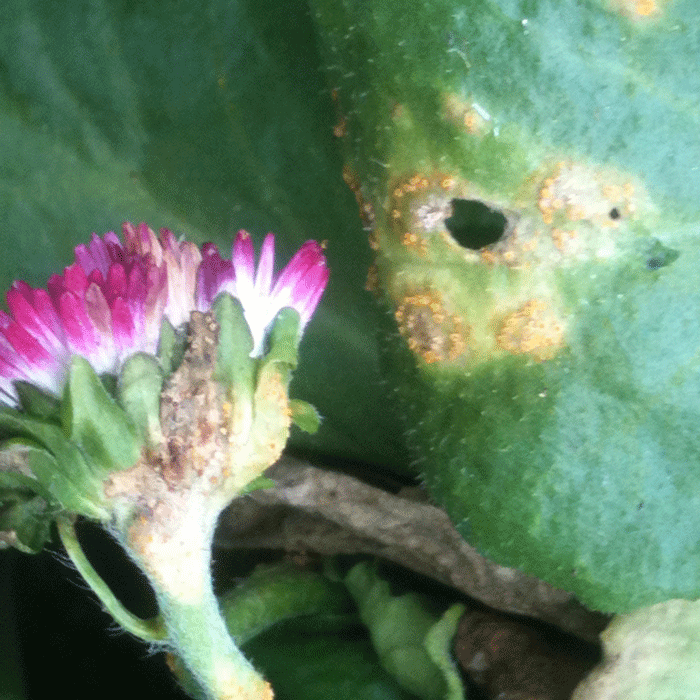Foliar Diseases
Just thinking about the costly damage that foliar diseases can cause is enough to give any bedding plant grower goosebumps. Luckily, advice is on hand to help prevent these plant-eating poltergeists from proliferating in our nurseries, says Rachel Anderson.
This Halloween saw my family and me toast marshmallows around the fire pit. As I looked around my garden, I realised that it’s rather fitting that autumn is the time of year when we temporarily focus our attentions on all things spooky. A few sinister foliar diseases have already destroyed a fair few of my plants – and have no doubt been trying to tip toe their way into growers’ nurseries too.
Certainly, life would be much easier if we all had a Ghostbusters-style “ghostzapper” to blast these little creeps off our plants. But as growers know, we are living in an era of limited chemical armoury and, with the need to protect our environment in mind, we must practice integrated pest management (IPM). An AHDB-led webinar on the control of foliar diseases in autumn-growing bedding plants saw a group of experts from ADAS deliver a timely reminder of this message.
Pathogens – keep out!
ADAS Horticulture associate director Dr Jill England advised growers to firstly create the kind of hygienic environment that will help prevent these little horrors from sneaking into their crops and creating a nightmare before Christmas.
This includes:
- Creating and displaying their hygiene policy so that everyone who comes into the nursery is familiar with how they want the plants to be managed
- Selecting disease-resistant varieties, where possible.
- Sourcing plants from an approved list of suppliers and even visiting their nurseries, where possible.
- Designating a separate “quarantine” area in which to check new stock when it arrives.
- Crop walking regularly and inspecting plants for signs of disease.
- Removing and disposing of crop debris, and bagging it up “in-situ” to avoid spreading any spores
- Using surface sterilants to clean the glasshouse, including production areas, trays and pots, and trolleys that they are reusing
- Controlling weeds, including non-cropped areas, as these are potentially secondary hosts.
The Creepy Culprits
ADAS consultant Chloe Whiteside listed the main “creepy culprits” to watch out for. These include:
- (devilish) downy mildew – a fungus-like pathogen that invades its hosts (such as poor, unsuspecting, pansies) from the inside out. Symptoms include patches of dull, yellowy-green areas on the upper leaf surface and the grey sporulation visible on the lower leaf surface.
- (petrifying) powdery mildew – a fungus that appears as a ghostly-white speckling across the leaves of bedding plants
- Boo! Botrytis/grey mould – a fluffy, grey-brown fungus that can remain dormant for up to three weeks until conditions become more favourable. Then, it causes its innocent victim to decay or even die
- (spooky) leaf spots – these begin as small, dark leaf spots of various different colours – from ghoulish greenish yellows to dark brown
- (revolting) rust – a fungal pathogen that is rather fond of Bellis, amongst other unsuspecting bedding plants, and appears as yellow rust-like distortions on the upper surface of the leaf and as orange-coloured rust pustules (gross!) on the lower surface.
- (beastly) bacterial diseases – these include the pathogens Pseudomonas syringae and Xanthomonas hortorum and symptoms include small, necrotic spots with a dark-coloured margin.

Rust on Bellis - Credit ADAS
Zombies – beware!
Each of these little zombies thrives in cool, damp conditions. Jill therefore recommended that growers improve air circulation around and within their crops. They can achieve this by keeping plants well-spaced, using fans, and ventilating the area well. They should also avoid applying overhead irrigation late in the day, when there isn’t enough time for the leaves to dry out. Where possible, the plants should be irrigated from below.
Stop the rot
Cultural controls should be used in the first instance – with chemical controls being the final option. There are several crop protection products – a combination of both protectant and eradicant fungicides and bioprotectants – that can be used on these fungal, foliar, diseases on autumn-grown bedding plants. However, ADAS consultant David Talbot stressed that growers must not use, in sequence, products that have the same FRAC (fungicide resistance action committee) code. Rather, the nursery’s spray programme must see FRAC codes alternated. David also emphasised that there is very limited available control for bacterial diseases, which is why – when it comes to controlling these foliar Frankensteins – “prevention is key.”
Usefully, a screening project run by the Bedding and Pot Plant Centre this year looked at some of the new products approved via EAMU for use on bedding plants for powdery mildew control. Products tested included Frupica FC, Karma, Reflect, Sercadis, and Topas.
Chloe said: “We wanted to test them to make sure that they didn’t give us any side effects or phytotoxicity when using them on these particular bedding species. We were pleased to see at the end of the trial that we didn’t have any phytotoxicity on any of the foliage or the flowers.”
Clearly, by following the experts’ advice, we can all to stop these unwanted gremlins from doing the Monster Mash in our bedding plants.
To view the webinar (which was first broadcast on September 29, 2020) visit www.ahdb.org.uk.
